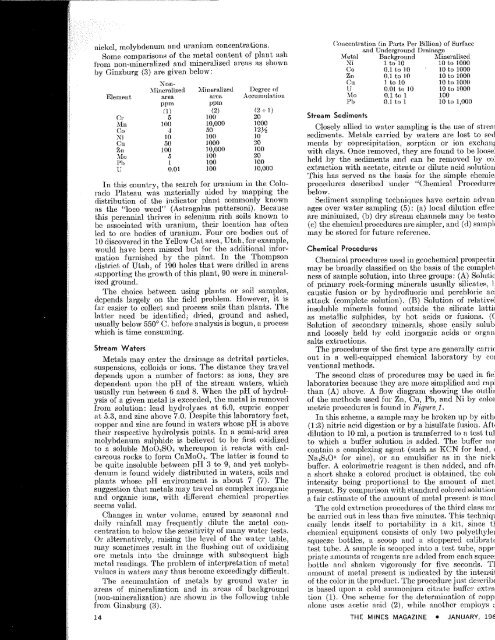1 - Mines Magazine - Colorado School of Mines
1 - Mines Magazine - Colorado School of Mines
1 - Mines Magazine - Colorado School of Mines
- No tags were found...
Create successful ePaper yourself
Turn your PDF publications into a flip-book with our unique Google optimized e-Paper software.
ni(;kel, molybdenum and uranium concenti'ations.Some comparisons <strong>of</strong> the metal content <strong>of</strong> plant ashfrom non-mineralized and mineralized areas as shownby Ginzburg (3) are given below:Noji-Mineralizeti Mineralized Degree <strong>of</strong>iRiemeiit area area AccumulationppmppmH) (2) (2-1)C,r 5 100 20Mn 100 10,000 1000Co 4 50 12^N'i 10 100 10Cu 50 1000 20Zn 100 10,000 iOOMo 5 100 20Pb 1 100 100U 0.01 JOO 10,000In this country, the search for uranuun in the <strong>Colorado</strong>Plateau was materially aided by mapping thedistribution <strong>of</strong> the indicator plant commonly knownas the "loco weed" (Astragalus pattersoni). Becausethis perennial thrives in selenium rich soils known tobe associated with uranium, theh location has <strong>of</strong>tenled to ore bodies <strong>of</strong> uranium. Four ore bodies out <strong>of</strong>10 discovered in the Yellow Cat area, Utah, for example,would have been missed but for the additional informationfurnished by the plant. In the Thompson(Ustrict <strong>of</strong> Utah, <strong>of</strong> 190 holes that were drilled in areas•supporting the growth <strong>of</strong> this plant, 90 were in mineralizedground.The choice between using plants or soil samples,depends largely on the field problem. However, it isfar easier to collect and process soils than plants. Thelatter need be identified,- dried, ground and ashed,usually below 550° C. before analysis is bcg-un, a processwliich is time consuming.Stream WatersMetals may enter thc drainage as detritai particles,suspensions, colloids or ions. The distance they traveldepends upon a number <strong>of</strong> factors: as ions, they aredependent upon the pH <strong>of</strong> the stream waters, whichusually run between 6 and 8. When the pld <strong>of</strong> hydrolysis<strong>of</strong> a given metal is exceeded, the metal is removedfrom solution: lead hydrolyzes at 6.0, cupric copperat 5.3, and zinc above 7.0. Despite this laboratory fact,copper and zinc are found in waters whose pH is abovethen- respective hydrolysis points. In a semi-arid areamolybdenum sulphide is believed to be first oxidizedto a soluble MoO^SO., whereupon it reacts with calcareousrocks to form CaMo04. The latter is found tobe quite insoluble between pH 3 to 9, and yet molybdenumis foimd widely distributed in waters, soils andplants whose pH environment is about 7 (7). Thesuggestion that metals may travel as complex inorganicand organic ions, with diiferent chemical propertiesseems valid.Changes in water volume, caused by seasonal anddaily rainfall may frequently dilute the metal concentrationto below the sensitivity <strong>of</strong> many water tests.Or alternatively, raising the level <strong>of</strong> the water table,may sometimes result in the flushing out <strong>of</strong> oxidizingore metals into the drainage with subsequent highmetal readings. The problem <strong>of</strong> interpretation <strong>of</strong> metalvalues in waters may thus become exceedingly difficult.The accumulation <strong>of</strong> metals by ground water inareas <strong>of</strong> mineralization and in areas <strong>of</strong> background(non-mincralization) are shown in the following tablefrom Ginzbtu'g (3).f Concentration fin Piirts Per Billion) <strong>of</strong> Surfaceand Underground Dj'ainageA'fetal Baekg]-ound MineralizedXi 1 to 10 10 to iOOO(]o 0.1 to 10 10 to 1000Zn 0.1 to to 10 to 1000Cu 1 to iO 10 to 1000\J 0.01 to 10 10 to 1000Mo 0.1 tn 1 100Pb 0.1 to 1 10 to 1,000Stream SedimentsClosely alfied to water sampling is the use <strong>of</strong> streamsediments. Metals carried by waters are lost to sedimentsby CO precipitation, sorption or ion exchangewith clays. Once removed, they are found to be looselyheld by the sediments and can be removed by coldextraction with acetate, citrate or dilute acid solutions.This has served as the Ijasis for the simple chemicalprocedtu'os described under "(chemical Procedures"below.Sediment sampling techniques have certain advanfagesover water sampling (5): (a) local dilution eft'ectsare minimized, (b) dry stream channels may be tested,(c) thc chemical procedures arc simpler, and (d) samplesmay be stored for future reference.Chemical ProceduresChemical procedures used in geochemical prospectingmay be broadly classified on thc basis <strong>of</strong> the completeness<strong>of</strong> sample solution, into three groups; (A) Solution<strong>of</strong> primary rock-forming minerals usually silicates, bycausti
















